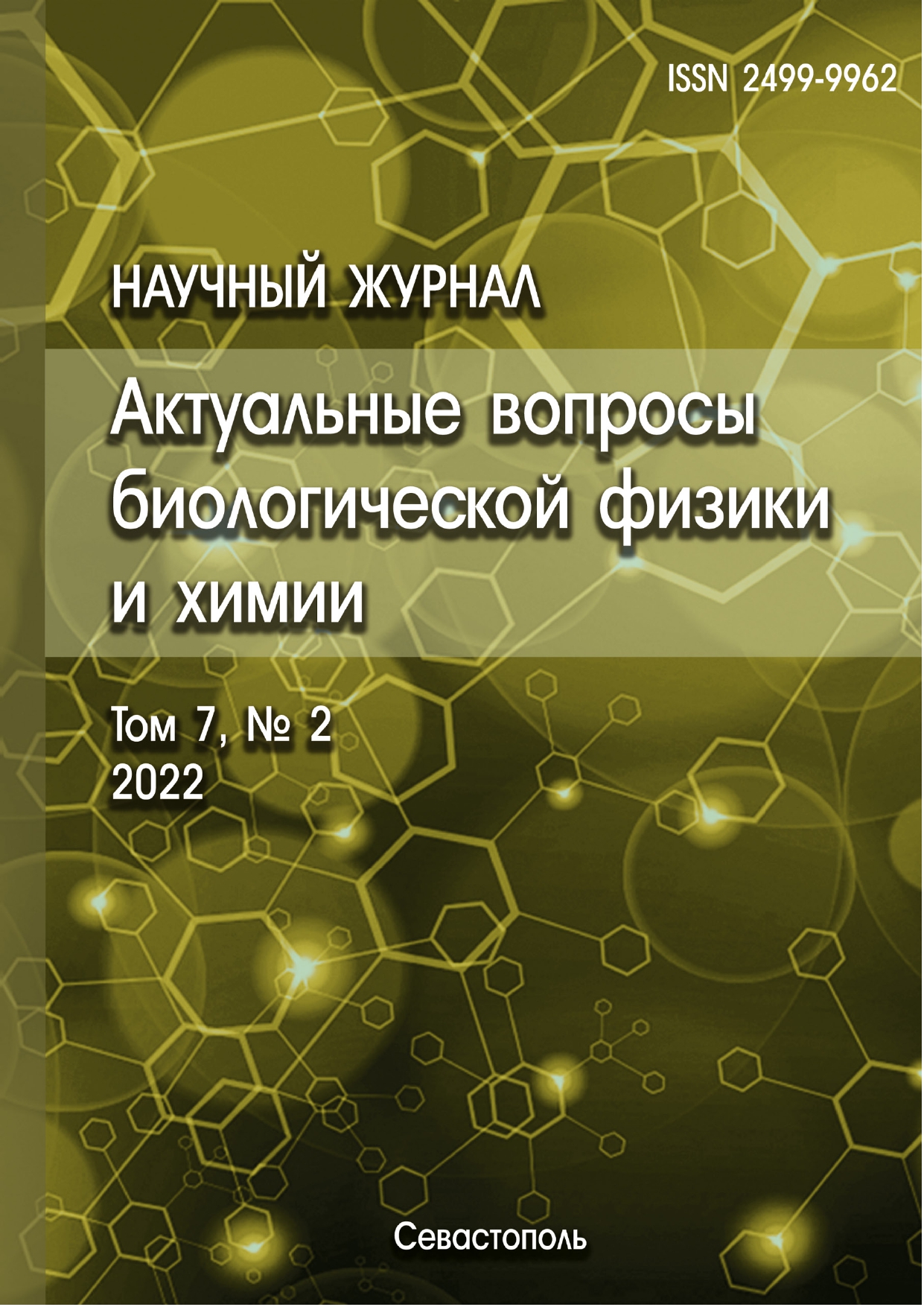Баку, Азербайджан
В работе квантовохимическим методом в рамках теории функционала электронной плотности DFT с гибридным трехпараметрическим функционалом B3LYP исследовано пространственное и электронное строение природного дипептида карнозина в таутомерной форме N3H его имидазольного кольца в газовой и в водной средах. Для расчета использовалcя достаточно надежный и экономичный по времени расчета расширенный базисный набор с учетом поляризационных и диффузных функций 6-31+G (d, p). Все вычисления выполнены с использованием пакета прикладных компьютерных программ Gaussian 09. Для визуализации полученных результатов использована программа GaussView 6.0.16. Получены геометрические параметры, значения электронной энергии, энергии HOMO и LUMO орбиталей и энергетический зазор между ними, дескрипторы реакционной способности, значения дипольных моментов, величины парциальных зарядов на атомах и теоретические ИК спектры для газовой и водной сред. Расчеты показывают, что предложенная модель молекулы образует стабильную структуру. Стабилизация полученной структуры обеспечена за счет образования нековалентных взаимодействий в дипептиде. Карты молекулярного электростатического потенциала MEP построены для определения потенциальных сайтов связывания. Для исследования переноса заряда и внутримолекулярных взаимодействий, определяющих стабильность молекулы, был проведен анализ орбиталей естественных связей (NBO). Проанализированы структурные перестройки и изменения различных параметров в зависимости от диэлектрической проницаемости среды.
карнозин, структура, дескрипторы реактивности, НБО анализ, ИК спектры
1. Болдырев А.А. Проблемы и перспективы исследования биологической роли карнозина. Биохимия, 2000, т. 65, № 7, с. 884-890.
2. Hipkiss A.R. Chapter 3: Carnosine and Its Possible Roles in Nutrition and Health. Advances in Food and Nutrition Research, 2009, vol. 57, pp. 87-154, doi: 10.1016 / S1043-4526 (09) 57003-9. DOI: https://doi.org/10.1016/S1043-4526(09)57003-9; EDN: https://elibrary.ru/MNDZNX
3. Gallant S., Kukley M., Stvolinsky S., Bulygina E., Boldyrev A. Effect of carnosine on rats under experimental brain ischemia. Tohoku J. Exp. Med., 2000, vol. 191, pp. 85-99, doi:https://doi.org/10.1620/tjem.191.85.
4. Prokopieva V.D., Yarygina E.G., Bokhan N.A. and Ivanova S.A.: Use of carnosine for oxidative stress reduction in different pathologies. Oxid Med Cell Longev, 2016, no. 29390872016, doi:https://doi.org/10.1155/2016/2939087. EDN: https://elibrary.ru/WPLKZL
5. Caruso G., Fresta C.G., Musso N. et al. Carnosine prevents Aβ-induced oxidative stress and inflammation in microglial cells: A key role of TGF-β1. Cells, 2019, vol. 8, p. 64, doi:https://doi.org/10.3390/cells8010064. EDN: https://elibrary.ru/CMFDUZ
6. Болдырев А.А. Карнозин. М.: Изд-во МГУ, 1998, 320 c.
7. Quinn P.J., Boldyrev A.A., Formazuyk V.E. Carnosine: its properties, functions and potential therapeutic applications. Mol Aspects Med., 1992, vol. 13, pp. 379-444, doi:https://doi.org/10.1016/0098-2997(92)90006-l. EDN: https://elibrary.ru/XOCGFS
8. Bonfanti L., Peretto P., De Marchis S., Fasolo A. Carnosine-related dipeptides in the mammalian brain. Prog.Neurobiol., 1999, vol. 59, pp. 333-353, doi:https://doi.org/10.1016/S0301-0082(99)00010-6. EDN: https://elibrary.ru/LTDPFV
9. Jain S., Kim E.S., Kim D., Burrows D., De Felice M., Kim M., Baek S.H., Ali A., Redgrave J., Doeppner T.R. et al. Comparative cerebroprotective potential of d- and l-carnosine following ischemic stroke in mice. Int. J. Mol. Sci., 2020, vol. 21, no. 9, pp. 3053-3065, doi:https://doi.org/10.3390/ijms21093053. EDN: https://elibrary.ru/MPLLOO
10. Zhao J., Posa D.K., Kumar V., Hoetker D., Kumar A., Ganesan S., Riggs D.W., Bhatnagar A., Wempe M.F., Baba S.P. Carnosine protects cardiac myocytes against lipid peroxidation products. Amino Acids, 2019, vol. 51, no. 1, pp. 123-138, doi:https://doi.org/10.1007/s00726-018-2676-6. EDN: https://elibrary.ru/WXWEPV
11. Zhao J., Shi L., Zhang L.-R. Neuroprotective effect of carnosine against salsolinol-induced Parkinson's disease. Exp. Ther. Med., 2017, vol. 14 no. 1, pp. 664-670, doi:https://doi.org/10.3892/etm.2017.4571. EDN: https://elibrary.ru/SVHZNZ
12. Calon F., Cole G. Neuroprotective action of omega-3 polyunsaturated fatty acids against neurodegenerative diseases: evidence from animal studies. Prostaglandins Leukot Essent Fatty Acids, 2007, vol. 77, no. 5-6, pp. 287-293, doi:https://doi.org/10.1016/j.plefa.2007.10.019.
13. Bermudez M.L., Seroogy K.B., Genter M.B. Evaluation of carnosine intervention in the Thy1-aSyn mouse model of Parkinson's disease. Neuroscience, 2019, vol. 411, pp. 270-278, doi:https://doi.org/10.1016/j.neuroscience.2019.05.026. EDN: https://elibrary.ru/EWBZNZ
14. Kilis-Pstrusinska K. Carnosine, carnosinase and kidney diseases. Postepy Hig Med Dosw, 2012, vol. 66, pp. 215-221, doi:https://doi.org/10.5604/17322693.991600. EDN: https://elibrary.ru/RQSRFV
15. Riedl E., Pfister F., Braunagel M., Brinkkötter P., Sternik P., Deinzer M., Bakker S.J., Henning R.H., van den Born J., Krämer B.K., Navis G., Hammes H.P., Yard B., Koeppel H. Carnosine prevents apoptosis of glomerular cells and podocyte loss in STZ diabetic rats. Cell Physiol Biochem., 2011, vol. 28, no. 2, pp. 279-288, doi:https://doi.org/10.1159/000331740.
16. Peters V., Zschocke J., Schmitt C.P. Carnosinase, diabetes mellitus and the potential relevance of carnosinase deficiency. J Inherit Metab Dis., 2018, vol. 41, no. 1, pp. 39-47, doi:https://doi.org/10.1007/s10545-017-0099-2. EDN: https://elibrary.ru/YEUTDV
17. Pfister F., Riedl E., Wang Q., vom Hagen F., Deinzer M., Harmsen M.C., Molema G., Yard B., Feng Y., Hammes H.P. Oral carnosine supplementation prevents vascular damage in experimental diabetic retinopathy. Cell Physiol. Biochem., 2011, vol. 28, no. 1, pp. 125-136, doi:https://doi.org/10.1159/000331721. EDN: https://elibrary.ru/PHMRWL
18. Rashid I., van Reyk D.M., Davies M.J. Carnosine and its constituents inhibit glycation of low-density lipoproteins that promotes foam cell formation in vitro. FEBS Lett., 2007, vol. 581, no. 5, pp. 1067-1070, doi:https://doi.org/10.1016/j.febslet.2007.01.082.
19. Mong M.C., Chao C.Y., Yin M.C. Histidine and carnosine alleviated hepatic steatosis in mice consumed high saturated fat diet. Eur J Pharmacol., 2011, vol. 653, no. 1-3, pp. 82-88, doi:https://doi.org/10.1016/j.ejphar.2010.12.001. EDN: https://elibrary.ru/XYIPFX
20. Boldyrev A.A., Aldini G., Derave W. Physiology and pathophysiology of carnosine. Physiol Rev., 2013, vol. 93, pp. 1803-1845, doi:https://doi.org/10.1152/physrev.00039.2012. EDN: https://elibrary.ru/SKWDVP
21. Hipkiss A.R., Baye E., de Courten B. Carnosine and the processes of ageing. Maturitas, 2016, vol. 93, pp. 28-33, doi:https://doi.org/10.1016/j.maturitas.2016.06.002. EDN: https://elibrary.ru/XTVXLH
22. Cararo J.H., Streck E.L., Schuck P.F., da C. Ferreira G. Carnosine and Related Peptides: Therapeutic Potential in Age-Related Disorders. Aging and Disease, 2015, vol. 6, no. 5, pp. 369-379, doi:https://doi.org/10.14336/AD.2015.0616. EDN: https://elibrary.ru/WVKTYX
23. Kawahara M., Tanaka K.-I., Kato-Negishi M. Zinc, Carnosine, and Neurodegenerative Diseases. Nutrients, 2018, vol. 10, no. 2, pp. 147-167, doi:https://doi.org/10.3390/nu10020147. EDN: https://elibrary.ru/VEEAIS
24. Shao L., Li Q., Tan Z. L-Carnosine reduces telomere damage and shortening rate in cultured normal fibroblasts. Biochemical and Biophysical Research Communications, 2004, vol. 324, no. 2, pp. 931-936, doi:https://doi.org/10.1016/j.bbrc.2004.09.136. EDN: https://elibrary.ru/LWLUCD
25. Hipkiss A.R. and Gaunitz F. Inhibition of tumour cell growth by carnosine: some possible mechanisms. Amino Acids, 2014, vol. 46, no. 2, pp. 327-337, doi:https://doi.org/10.1007/s00726-013-1627-5. EDN: https://elibrary.ru/SPNRPL
26. Gaunitz F., Hipkiss A.R. Carnosine and cancer: a perspective. Amino Acids, 2012, vol. 43, no. 1, pp. 135-142, doi:https://doi.org/10.1007/s00726-012-1271-5. EDN: https://elibrary.ru/PIOLBF
27. Chuang C.-H., Hu M.-L. L-Carnosine Inhibits Metastasis of SK-Hep-1 Cells by Inhibition of Matrix Metaoproteinase-9 Expression and Induction of an Antimetastatic Gene, nm23-H1. Nutr Cancer, 2008, vol. 60, no. 4, pp. 526-533, doi:https://doi.org/10.1080/01635580801911787. EDN: https://elibrary.ru/XXMQDZ
28. Hsieh S.-L., Hsieh S., Lai P.-Y., Wang J.-J., Li C.-C., Wu C.-C. Carnosine suppresses human colorectal cell migration and intravasation by regulating EMT and MMP expression. Am J Chin Med, 2019, vol. 47, no. 2, pp. 477-494, doi:https://doi.org/10.1142/s0192415x19500241. EDN: https://elibrary.ru/GDINXJ
29. Wu C.-C, Lai P.-Y, Hsieh S., Cheng C.-C., Hsieh S.-L. Suppression of carnosine on adhesion and extravasation of human colorectal cancer cells. Anticancer Res., 2019, vol. 39, no. 11, pp. 6135-6144, doi:https://doi.org/10.21873/anticanres.13821. EDN: https://elibrary.ru/AQWHUC
30. Shen Y., Yang J., Li J., Shi X., Ouyang L., Tian Y., Lu J. Carnosine inhibits the proliferation of human gastric cancer SGC-7901 cells through both of the mitochondrial respiration and glycolysis pathways. PLoS ONE, 2014, vol. 9, no. 8, e104632, doi:https://doi.org/10.1371/journal.pone.0104632. EDN: https://elibrary.ru/UUCKED
31. Zhang Z., Miao L., Wu X., Liu G., Peng Y., Xin X., Jiao B., Kong X. Carnosine inhibits the proliferation of human gastric carcinoma cells by retarding Akt/mTOR/p70S6K signaling. J. Cancer., 2014, vol. 5, pp. 382-389, doi:https://doi.org/10.7150/jca.8024.
32. Lee J., Park J.R., Lee H., Jang S., Ryu S.M., Kim H., Kim D., Jang A., Yang S.R. L-carnosine induces apoptosis/cell cycle arrest via suppression of NF-κB/STAT1 pathway in HCT116 colorectal cancer cells. In Vitro Cell Dev Biol Anim., 2018, vol. 54, pp. 505-512, doi:https://doi.org/10.1007/s11626-018-0264-4. EDN: https://elibrary.ru/JSHKEQ
33. Shu-Ling Hsieh, Jia-Huei Li, Cheng-Di Dong, Chiu-Wen Chen, Chih-Chung Wu. Carnosine suppresses human colorectal cancer cell proliferation by inducing necroptosis and autophagy and reducing angiogenesis. Oncol Lett., 2022, vol. 23, no. 2, p. 44, doi:https://doi.org/10.3892/ol.2021.13162.
34. Wu G. Important roles of dietary taurine, creatine, carnosine, anserine and 4-hydroxyproline in human nutrition and health. Amino Acids, 2020, doi:https://doi.org/10.1007/s00726-020-02823-6.
35. Demukhamedova S.D., Alieva I.N., Godjayev N.M. Spatial and electronic structure of monomeric and dimeric complexes of carnosine with zinc. J. Struct. Chem., 2010, vol. 51, no. 5, pp. 824-832, doi:https://doi.org/10.1007/s10947-010-0127-7. EDN: https://elibrary.ru/OKUEGP
36. Demukhamedova S.D., Alieva I.N., Gajiyev Z.I. Quantum chemistry investigation of the carnosine polymer complex with zinc. Fizika, 2010, vol. 16, no. 2, pp. 597-600.
37. Демухамедова С.Д., Алиева И.Н., Гаджиев З.И., Годжаев Н.М. Ab initio исследование структуры и колебательного спектра молекулы карнозина. Journal of Qafqaz University, 2009, № 27, c. 15-25.
38. Демухамедова C.Д. Пространственная структура димерных комплексов карнозина с медью. Journal of Qafqaz University, 2010, № 29, c. 37-47.
39. Демухамедова C.Д., Алиева И.Н., Годжаев Н.М. Квантово-химический анализ заселенностей координационных связей в димерных комплексах карнозина с атомами меди и воды. Известия НАНА, физика и астрономия, 2011, № 2, с. 65-77.
40. Демухамедова C.Д. Квантовохимическое исследование комплексов двух таутомерных форм карнозина с кобальтом. Aктуальные вопросы биологической физики и химии, 2019, т. 4, № 4, c. 505-513.
41. Akverdieva G.A., Alieva I.N., Hajiyev Z.I., Demukhamedova S.D. Spatial structure of N1H and N3H tautomers of carnosine in zwitterion form. AJP Fizika, 2021, vol. 27, no. 2, pp. 29-37.
42. Diez R.P., Baran E.J. A density functional study of some physical properties of carnosine (N-b-alanyl-L-histidine). J Mol Struct (Theochem), 2003, vol. 621, pp. 245-251, doi:https://doi.org/10.1016/S0166-1280(02)00587-0. EDN: https://elibrary.ru/LTDPHT
43. Tyunina E.Y., Mezhevoi I.N., Dunaeva V.V. Thermodynamic properties of crystalline L-carnosine and its aqueous solutions. The Journal of Chemical Thermodynamics, 2020, vol. 150, 106206, doi:https://doi.org/10.1016/j.jct.2020.
44. Baran E.J. Metal complexes of carmnosine. Biochemistry, 2000, vol. 65, no. 7, pp. 789-797.
45. Frisch M.J. et al. Gaussian 09, Revision D.01, Gaussian, Inc., Wallingford CT, 2013.
46. Dennington R., Keith T., Millam J. Gauss View, Version 6.0.16. Shawnee, Kansas: Semichem Inc., Shawnee Mission, 2016.
47. Itoh H., Yamane T., Ashida T. Carnosine (-Alanyl-L-histidine). Acta Cryst., 1977, vol. B33, pp. 2959-2961, doi:https://doi.org/10.1107/S0567740877009972.
48. Koopmans T. Uber die Zuordnung von Wellenfunktionen und Eigenwerten zu den Einzelnen Elektronen Eines Atoms. Physica, 1934, vol.1, no. 1-6, pp. 104-113, doi:https://doi.org/10.1016/s0031-8914(34)90011-2.
49. Weinhold F., Landis C.R. Valency and Bonding: A Natural Bond Orbital Donor-Acceptor Perspective. Cambridge University Press, 2005. DOI: https://doi.org/10.1017/CBO9780511614569; EDN: https://elibrary.ru/SSSATA










